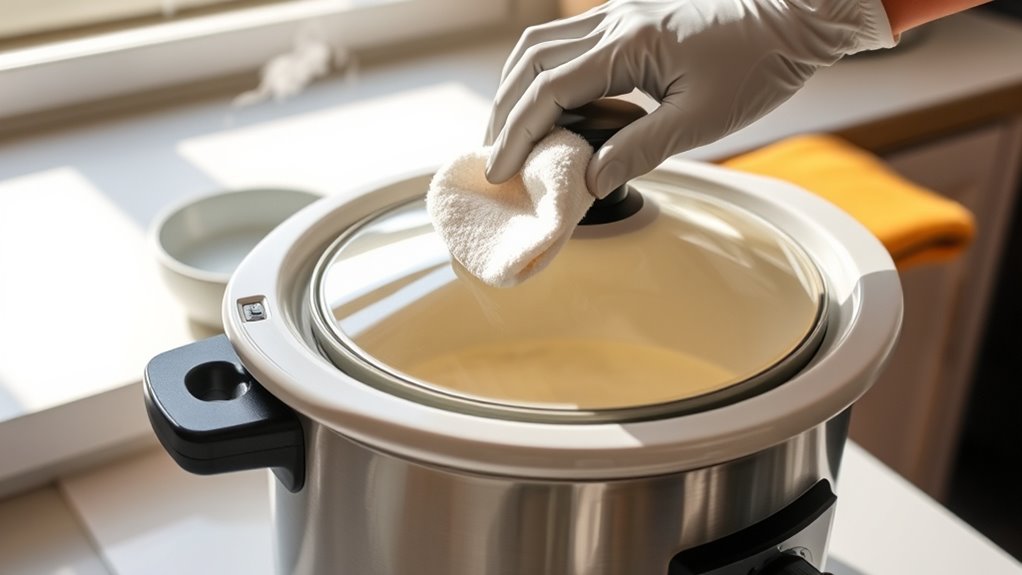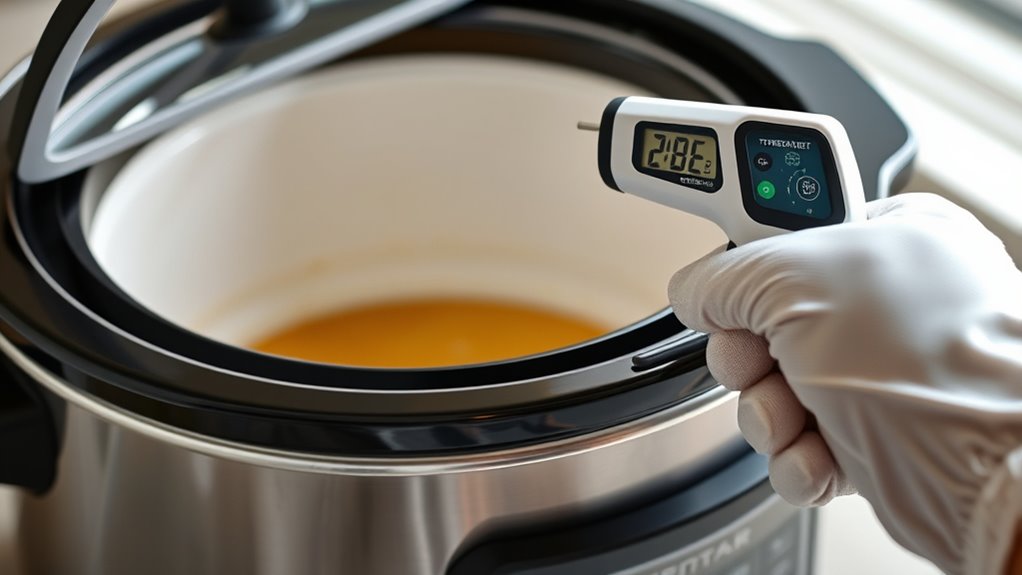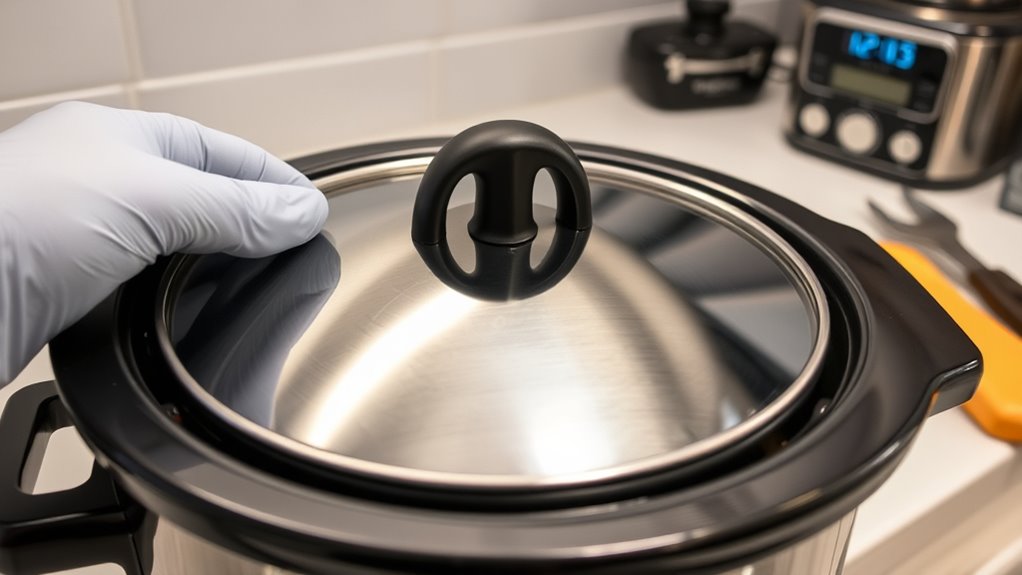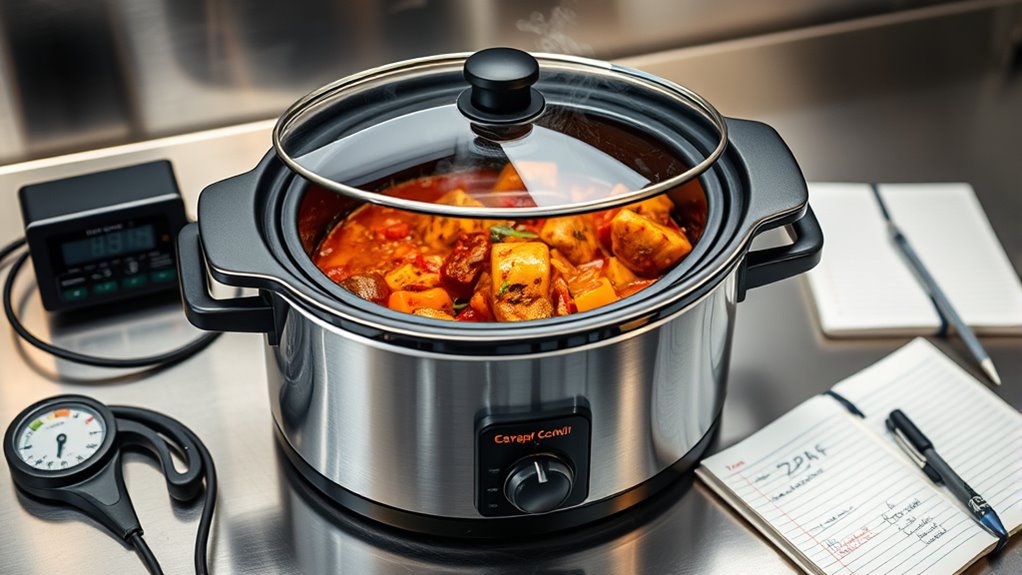To keep your slow cooker timing perfect, clean it regularly with gentle soap and a soft sponge, and inspect the lid gasket and hinges for wear. Check the heating element and calibrate the temperature settings using a reliable thermometer to guarantee accurate heat levels. Always secure power cords safely and avoid damage. Performing routine maintenance helps maintain consistent cooking results—stay tuned to discover even more tips to optimize your slow cooker performance.
Key Takeaways
- Regularly inspect and replace the heating element to ensure even and accurate cooking temperatures.
- Calibrate the thermostat periodically using a reliable thermometer for precise timing.
- Keep the lid gasket clean and intact to maintain proper heat retention and consistent cooking times.
- Check power cords and connections for damage to prevent interruptions during operation.
- Clean and maintain the slow cooker thoroughly after each use to prevent residue buildup affecting timing accuracy.
Regular Cleaning and Care of Your Slow Cooker

Regular cleaning and care are essential to keep your slow cooker functioning properly and to guarantee your food stays safe to eat. After preparing your favorite slow cooker recipes, always unplug and let it cool before cleaning. Remove the lid and wash it separately to prevent buildup. Use gentle dish soap and a soft sponge to clean the ceramic insert and lid, avoiding abrasive scrubbers that could damage the surfaces. Wipe down the exterior with a damp cloth. Proper kitchen organization helps you keep track of cleaning supplies, making maintenance quicker. Regular care prevents residue buildup, reduces odors, and extends your slow cooker’s lifespan. Incorporating a routine cleaning schedule ensures your appliance remains in top condition, so you can enjoy delicious recipes without worry.
Inspecting and Replacing the Heating Element

Regularly inspecting your slow cooker’s heating element helps catch signs of wear early. If you notice it’s damaged or not heating properly, substituting the component is essential for safe operation. Taking these steps ensures your slow cooker continues to cook safely and efficiently. Additionally, consulting the manufacturer’s guidelines can help identify proper replacement parts and maintenance procedures for optimal performance.
Heating Element Wear
Over time, the heating element in your slow cooker can wear out or become less efficient, affecting its cooking performance. Signs of heating element wear include uneven heating or longer cook times. Inspect the electrical connections regularly to verify they’re secure and free of corrosion or damage. Loose or corroded connections can cause inconsistent heating and may lead to further damage. Carefully unplug the cooker before inspecting the element. Check for visible signs of wear such as discoloration, warping, or cracks. If the element appears damaged or isn’t heating properly despite secure connections, it’s time to contemplate replacing it. Proper inspection helps maintain ideal performance and prevents unexpected failures during your cooking routine. Regular maintenance and understanding appliance lifespan can extend the longevity of your slow cooker.
Replacing Damaged Components
When you notice your slow cooker isn’t heating properly or the cooking times seem off, it’s important to inspect the heating element for damage. If it’s broken or shows signs of wear, replacing it guarantees safe, efficient operation. Before doing so, unplug the appliance and disconnect the heating element carefully. Make sure to evaluate ingredient compatibility with the new part to prevent future issues. Always prioritize storage safety by storing spare parts properly away from moisture and heat sources. When replacing the heating element, consider these tips:
- Verify compatibility with your slow cooker model
- Use genuine replacement parts for durability
- Follow manufacturer instructions precisely
- Test the cooker after installation to confirm proper function
Checking and Calibrating the Temperature Settings

Since the temperature settings on your slow cooker can vary between models, it’s important to verify that they heat accurately. Start by testing the thermostat calibration to ensure the temperature accuracy matches the settings. Fill the slow cooker with water and set it to a specific temperature, like low or high, then use a reliable kitchen thermometer to check the actual temperature after an hour. If there’s a discrepancy, you may need to adjust the thermostat calibration or consider professional calibration if possible. Regularly checking these settings guarantees your slow cooker maintains consistent heat, preventing undercooking or overcooking. Automation in appliances continues to improve, making such calibrations more precise and user-friendly. Accurate temperature control is essential for perfect slow cooking results, so don’t skip this step in your routine maintenance. Proper calibration keeps your cooking precise and your meals delicious.
Proper Lid Maintenance for Optimal Sealing

Maintaining your slow cooker’s lid properly is essential for guaranteeing a tight seal that traps heat and moisture effectively. A well-maintained lid gasket creates an airtight barrier, preventing heat loss and ensuring even cooking. Regularly inspect the gasket for cracks or wear, replacing it when necessary. Hinge maintenance is equally important; check hinges for looseness or damage and tighten or repair as needed to keep the lid aligned. Clean the lid and gasket with mild soap and water after each use to prevent residue buildup. Proper lid upkeep minimizes steam escapes, maintains consistent temperatures, and prolongs your slow cooker’s lifespan. Additionally, understanding the best free keto diet app can help maintain your diet while managing your cooking routine effectively.
Ensuring Power Connections and Cord Safety

Ensuring your slow cooker’s power connections and cords are safe is essential for preventing electrical hazards and ensuring reliable operation. Check that the cord is undamaged, with no frays or cracks, to maintain proper cord safety. Make sure the power connection is secure and free from moisture or debris. Avoid overloading outlets or using extension cords that aren’t rated for the appliance’s power. Keep cords away from hot surfaces and water to prevent accidents. Regularly inspect the cord and plug for damage, replacing them if necessary. Use the table below to help identify potential issues and safe practices:
| Issue | Warning Signs | Action Needed |
|---|---|---|
| Damaged cord | Frays, cracks | Replace immediately |
| Loose connection | Plug feels loose | Secure or replace plug |
| Overloaded outlet | Frequent trips | Use a dedicated outlet |
| Water near plug | Visible moisture | Dry thoroughly, unplug |
| Excessive cord strain | Bending or pulling | Use cord clips or reroute |
Furthermore, consulting industry standards can help ensure your setup meets safety regulations.
Routine Performance Tests for Consistent Results

Regular performance tests are essential to guarantee your slow cooker cooks food evenly and reliably. By routinely checking its performance, you can identify issues early and make necessary recipe adjustments or refine your cooking techniques. This helps ensure consistent results every time you cook. To perform these tests, consider the following:
- Use a simple test recipe and record cooking times at different settings
- Check for hot spots or uneven heating patterns
- Measure internal temperatures to verify accurate heat levels
- Adjust cooking techniques based on test outcomes for better consistency
These steps help you fine-tune your slow cooker’s performance, ensuring each meal turns out just right. Regular tests keep your appliance functioning at its best and guarantee predictable, delicious results with every use.
Frequently Asked Questions
How Often Should I Replace My Slow Cooker’s Thermostat?
You should replace your slow cooker’s thermostat every 3 to 5 years, depending on usage and performance. Regular thermostat calibration helps make certain of accurate temperatures, but if you notice inconsistent cooking or temperature fluctuations, it’s time for replacement. Don’t ignore these signs, as faulty thermostats can affect cooking results and safety. Regular maintenance and timely thermostat replacement keep your slow cooker functioning properly and extend its lifespan.
What Are Signs of a Faulty Slow Cooker Heating Element?
If your slow cooker isn’t heating properly, it could be a faulty heating element, which affects its lifespan. Signs include uneven cooking, no heat despite being plugged in, or the element feeling hot to the touch but not heating. When you notice these issues, it’s time for heating element replacement. Regular maintenance helps prolong your slow cooker’s lifespan and guarantees consistent, safe cooking every time.
How Do I Troubleshoot Uneven Cooking Times?
Did you know that improper temperature calibration causes 60% of uneven cooking issues? To troubleshoot, first check if your slow cooker’s temperature setting is accurate—use a thermometer to verify. Next, make certain the lid fits snugly; a loose lid lets heat escape, leading to uneven results. Adjust or replace the lid if needed, and recalibrate your cooker to maintain consistent temperature control for perfect cooking every time.
Can I Use My Slow Cooker Outdoors Safely?
Yes, you can use your slow cooker outdoors safely if it’s weather-resistant and designed for outdoor cooking. Place it on a stable, flat surface away from direct sunlight, rain, or wind. Avoid using it in wet conditions, and always supervise while cooking outside. Make sure to follow the manufacturer’s instructions for outdoor use, and consider using a covered area or a weatherproof enclosure to protect it from the elements.
What Safety Precautions Prevent Electrical Hazards During Maintenance?
To prevent electrical hazards during maintenance, you should always unplug your slow cooker before cleaning or inspecting it. Guarantee electrical safety by checking that the appliance is properly grounded, which reduces the risk of shocks. Avoid using water near electrical parts, and never operate the slow cooker with damaged cords or plugs. Following these safety precautions keeps you safe and maintains your appliance’s performance.
Conclusion
So, after all that care, you’d think your slow cooker would never let you down. But even with perfect maintenance, it’s funny how sometimes your dinner still takes forever or burns unexpectedly. Irony, isn’t it? You do everything right, yet the unpredictable still sneaks in. Still, with patience and a little troubleshooting, you’ll keep those slow cooker secrets at bay—until next time, when it surprises you again. Happy cooking, despite the quirks!










